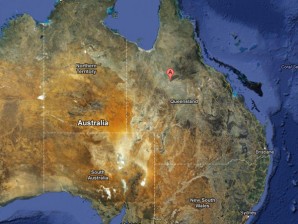
The new species, named Obdurodon tharalkooschild, was identified by a single but highly distinctive tooth found in the Riversleigh site in the northeastern Australian state of Queensland – a World Heritage area rich in fossil deposits.
“We’d never seen anything this big so it really knocked our socks off to think that platypus could get this big,” said Professor Mike Archer from the University of New South Wales, who described the animal as about twice the size of its modern relative.
“Platypus Godzilla. You can imagine the humorous scenes where somebody looks at the modern platypus and says ‘That’s not a platypus’ and then picks up this monster and says ‘That’s a platypus’.”
The modern platypus, a timid and nocturnal animal which lives in deep waterside burrows and is found only in eastern Australia, lacks any teeth as an adult. Scientists do not believe the newly discovered extinct species was an immediate ancestor.
Archer said the extinct version would have been “positively dangerous” and turns on its head the idea of the creature as small, furry and “cute.”
“We already know that the modern platypus has venom on the spurs of the hind leg that can be incredibly painful, that can stop a grown man in his tracks for hours,” said Archer.
“If you scale that up to perhaps two to three times the amount of venom in an animal much larger than that, you suddenly start thinking about this animal as a predator.”
Scientists had thought that the platypus, which combines bird, mammal and reptile characteristics, had gradually lost its teeth and become smaller over millions of years. But the latest find contradicts that theory because it is much bigger than older, toothed incarnations of the mysterious monotreme.
“Discovery of this new species was a shock to us because prior to this, the fossil record suggested that the evolutionary tree of platypuses was a relatively linear one,” Archer explained.
“Now we realize that there were unanticipated side branches on this tree, some of which became gigantic.”
Archer said he was confident that the single tooth, which was discovered by Rebecca Pian, a PhD candidate at Columbia University in the United States, was sufficient evidence of a new species.
The tooth proved it was a platypus, and it was very different from any other toothed platypus seen.
“This single tooth that turned up is precisely the one that we needed,” he said.
Pian, the lead author of the research published in the US-based Journal of Vertebrate Palaeontology, said any new species, even though incomplete, was an important aid in understanding more about the fascinating mammals.
The extinct species is believed to have been a mostly aquatic animal like its modern descendant and would have lived in and around freshwater pools in the forests that covered the Riversleigh area millions of years ago.
It probably fed on crayfish and other freshwater crustaceans, as well as small vertebrates such as frogs and turtles, said Suzanne Hand of UNSW’s School of Biological Earth and Environmental Sciences.
Archer said scientists already had concerns about the long-term viability of the platypus given the animals’ long and steady decline over millions of years, and the discovery only added to these.
The find indicates that where there could have once have been more kinds of platypus, these have now vanished.

